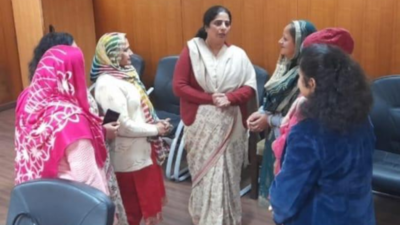- News
- City News
- gurgaon News
- How a VC is helping women sarpanches lead from front
Trending Topics
How a VC is helping women sarpanches lead from front

GURGAON: In Sonipat’s Gamri village, the newly elected village sarpanch Sheela tends to the household chores as her husband, Balraj Singh, calls the shots on crucial matters related to the area. Four kilometres away, at Khanpur Kalan village, Sangeeta Devi, who was elected as the sarpanch last year, readily allows her husband, Dilawar, to answer phone calls and attend panchayat meetings.
A total of 151 women sarpanches were elected across the Sonipat district last year, but like Sheela and Sangeeta, most of these women have been relegated to nominal roles. “How can she (Sheela) take care of all this work? If she attends the panchayat meetings, who will cook food and clean the house?” asks 48-year-old Balraj, the sarpanch pati, as the term goes.

The concept of ‘sarpanch pati’, where men relatives (mostly husbands) of elected women run the office in their stead, is now immortalised even on celluloid, like in a recent web series ‘Panchayat’.
It is this concept of proxy politics that Bhagat Phool Singh Women’s University vice-chancellor Sudesh Chhikara is trying to change. Her Clarion call to women: "lift your veil".
"There’s a chasm between our policies aimed at empowering women and the ground reality. While we have made great strides in giving 50% representation to women in Panchayati Raj institutions, it has not translated into women taking up leadership roles in villages. They are still home-bound and behind the veil, while their male counterparts lead on their behalf," Chhikara says.
How it began
Chhikara, 57, assumed charge as the vice-chancellor of a century-old women’s varsity at Sonipat's Khanpur Kalan village in March last year. That month she was invited to attend a panchayat meeting at Khanpur Kalan. This meeting came as a rude awakening to Chhikara as the then sarpanch was relegated to the backseat and not allowed to interact.
"If this is the state of women’s sarpanch in a village that has over a century-old women’s university, I shuddered to imagine what would be the state of woman heads in other villages. As an educator and head of a university, I vowed to change this and push these women to break their proverbial glass ceilings," she says.
Towards the second half of 2022, the district went to polls to elect new panchayat representatives. Of the 318 villages that went to polls, 48% elected women candidates as their heads in Sonipat. While the government celebrated and touted it as a testimony of its endeavours toward women's empowerment, Chhikara remained unsettled knowing that most of these newly elected sarpanches took oath behind the veil and slowly retreated to the backseat. It was then she embarked upon a journey to bring a change, at least in the nearby villages.
Chhikara found a comrade in then additional CEO of zila parishad Ankita Verma, who helped her get the newly elected women sarpanches in the district under one roof for a two-day training session.
For Gurgaon-born Verma, this was an opportunity she was waiting for. “It was my second posting after clearing Haryana Civil Service (HCS) exam. Throughout the course of the election, I noticed that women candidates rarely showed up to raise queries or get any clarification. It was always some male members in the family. And I, too, wanted to do something about it. With Chhikara and push from the administration, we chalked out a two-day training programme,” she says.
How is it going?
Forty-two women sarpanches registered for this two-day training session in January. A visit to the varsity campus and session in conference rooms were something they had never experienced.
"It made us feel important. I’ve never been to college or attended any big meetings. It was an honour. I’d want to attend more of such meetings,” Sangeeta tells TOI.
In her sessions thus far, Chhikara has made women sarpanches aware of the nature and structure of panchayat funds and how to utilise them. She also covered topics like drug addiction, unemployment among youths, overindulgence in social media, the status of schools and primary healthcare centres, open defecation, the need for community centres, the drainage system, and the role of Anganwadi.
“Initially, we wanted to understand their psyche. So, we asked them basic questions like what it means to be a woman sarpanch and what changes they want to see in their villages. Gradually, we went deeper into their roles and how they can exercise them. By the end of the first session, these women were beaming with excitement,” Chhikara says.
But the educationist is aware that to bring a change these sessions need to have continuity. “Old habits last long and old traditions even longer. We will continue to have these sessions periodically. I also plan to include some workshops and a series of interactions with the administration so that they become visible faces and know how bureaucracy and governance systems work,” she adds.
Easier said than done
The sessions, thus far, have only helped these women to step out of their homes for a purpose other than household chores or family functions. The tangible changes, where these women assume charge of the positions they have been elected, are likely to take longer.
“We have lived in this kind of society for generations. We, too, want a change but it will not come overnight. Government cannot expect that one day they will elect us as sarpanch and we will start acting like one immediately. Firstly, we are not trained and don’t understand most of the documentation work. Secondly, there’s deep conditioning that cannot be challenged all of a sudden,” asserts 40-year-old Parmila Devi, sarpanch of Kailana Khas village in Gohana block of Sonipat.
Chhikara isn’t dismissive of these challenges but she says that it’s not a tradition but a conditioning that acts as an impediment.
“This university was opened 100 years ago by the community, which means people of that time wanted to promote women’s education. Confining women behind the veil and limiting them to household chores is not a tradition but a conditioning that emerged out of various socio-economic realities that may have existed decades ago. And that conditioning has to be abolished from the minds of the people. It is not easy, but we can try,” she adds.
A total of 151 women sarpanches were elected across the Sonipat district last year, but like Sheela and Sangeeta, most of these women have been relegated to nominal roles. “How can she (Sheela) take care of all this work? If she attends the panchayat meetings, who will cook food and clean the house?” asks 48-year-old Balraj, the sarpanch pati, as the term goes.

The concept of ‘sarpanch pati’, where men relatives (mostly husbands) of elected women run the office in their stead, is now immortalised even on celluloid, like in a recent web series ‘Panchayat’.
It is this concept of proxy politics that Bhagat Phool Singh Women’s University vice-chancellor Sudesh Chhikara is trying to change. Her Clarion call to women: "lift your veil".
"There’s a chasm between our policies aimed at empowering women and the ground reality. While we have made great strides in giving 50% representation to women in Panchayati Raj institutions, it has not translated into women taking up leadership roles in villages. They are still home-bound and behind the veil, while their male counterparts lead on their behalf," Chhikara says.
How it began
Chhikara, 57, assumed charge as the vice-chancellor of a century-old women’s varsity at Sonipat's Khanpur Kalan village in March last year. That month she was invited to attend a panchayat meeting at Khanpur Kalan. This meeting came as a rude awakening to Chhikara as the then sarpanch was relegated to the backseat and not allowed to interact.
"If this is the state of women’s sarpanch in a village that has over a century-old women’s university, I shuddered to imagine what would be the state of woman heads in other villages. As an educator and head of a university, I vowed to change this and push these women to break their proverbial glass ceilings," she says.
Towards the second half of 2022, the district went to polls to elect new panchayat representatives. Of the 318 villages that went to polls, 48% elected women candidates as their heads in Sonipat. While the government celebrated and touted it as a testimony of its endeavours toward women's empowerment, Chhikara remained unsettled knowing that most of these newly elected sarpanches took oath behind the veil and slowly retreated to the backseat. It was then she embarked upon a journey to bring a change, at least in the nearby villages.
Chhikara found a comrade in then additional CEO of zila parishad Ankita Verma, who helped her get the newly elected women sarpanches in the district under one roof for a two-day training session.
For Gurgaon-born Verma, this was an opportunity she was waiting for. “It was my second posting after clearing Haryana Civil Service (HCS) exam. Throughout the course of the election, I noticed that women candidates rarely showed up to raise queries or get any clarification. It was always some male members in the family. And I, too, wanted to do something about it. With Chhikara and push from the administration, we chalked out a two-day training programme,” she says.
How is it going?
Forty-two women sarpanches registered for this two-day training session in January. A visit to the varsity campus and session in conference rooms were something they had never experienced.
"It made us feel important. I’ve never been to college or attended any big meetings. It was an honour. I’d want to attend more of such meetings,” Sangeeta tells TOI.
In her sessions thus far, Chhikara has made women sarpanches aware of the nature and structure of panchayat funds and how to utilise them. She also covered topics like drug addiction, unemployment among youths, overindulgence in social media, the status of schools and primary healthcare centres, open defecation, the need for community centres, the drainage system, and the role of Anganwadi.
“Initially, we wanted to understand their psyche. So, we asked them basic questions like what it means to be a woman sarpanch and what changes they want to see in their villages. Gradually, we went deeper into their roles and how they can exercise them. By the end of the first session, these women were beaming with excitement,” Chhikara says.
But the educationist is aware that to bring a change these sessions need to have continuity. “Old habits last long and old traditions even longer. We will continue to have these sessions periodically. I also plan to include some workshops and a series of interactions with the administration so that they become visible faces and know how bureaucracy and governance systems work,” she adds.
Easier said than done
The sessions, thus far, have only helped these women to step out of their homes for a purpose other than household chores or family functions. The tangible changes, where these women assume charge of the positions they have been elected, are likely to take longer.
“We have lived in this kind of society for generations. We, too, want a change but it will not come overnight. Government cannot expect that one day they will elect us as sarpanch and we will start acting like one immediately. Firstly, we are not trained and don’t understand most of the documentation work. Secondly, there’s deep conditioning that cannot be challenged all of a sudden,” asserts 40-year-old Parmila Devi, sarpanch of Kailana Khas village in Gohana block of Sonipat.
Chhikara isn’t dismissive of these challenges but she says that it’s not a tradition but a conditioning that acts as an impediment.
“This university was opened 100 years ago by the community, which means people of that time wanted to promote women’s education. Confining women behind the veil and limiting them to household chores is not a tradition but a conditioning that emerged out of various socio-economic realities that may have existed decades ago. And that conditioning has to be abolished from the minds of the people. It is not easy, but we can try,” she adds.
Start a Conversation
FOLLOW US ON SOCIAL MEDIA
FacebookTwitterInstagramKOO APPYOUTUBE










